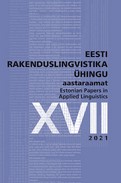EESTI KEELE KUI TEISE KEELE ÕPETAJA TÖÖRIISTAD EESTI KEELE INSTITUUDI KEELEPORTAALIS SÕNAVEEB
ESTONIAN AS A SECOND LANGUAGE TEACHER’S TOOLS IN THE INSTITUTE OF ESTONIAN LANGUAGE’S LANGUAGE PORTAL SÕNAVEEB
Author(s): Jelena Kallas, Kristina Koppel, Raili Pooli, Katrin Tsepelina, Tiiu Üksik, Pilvi Alp, Anu EpneriSubject(s): Language acquisition, Finno-Ugrian studies, School education, Pedagogy
Published by: Eesti Rakenduslingvistika Ühing (ERÜ)
Keywords: Corpus Lexicography; Linguistic Competence; Grammar Competence; CEFR; Second Language acquisition; Estonian as a Second Language;
Summary/Abstract: The paper presents the interim results of the project Teacher’s Tools (Õpetaja tööriistad) published as a subpage of the language portal Sõnaveeb. The toolbox includes four modules: vocabulary, grammar, language use situations and text evaluation. The tools are aimed to help second language teachers and specialists plan courses and create new educational materials, exercises and tests. The methodological framework and CEFR level evaluation for Teacher’s Tools is based on the Common European Framework of Reference for Languages: Learning, teaching, assessment (2001), its Companion Volume with New Descriptors (2018), Collated Representative Samples of Descriptors of Language Competences Developed for Young Learners for Ages 7–10 (Szabo 2018a) and 11–15 (Szabo 2018b) and Estonian legislation on the topic. The methodology is adapted from similar projects for other languages (e.g. Capel 2010, 2012, O’Keeffe, Geraldine 2017, Alfter et al. 2019). In order to gather linguistic data the Institute of Estonian Language compiled Estonian language coursebook and learner’s language corpuses in 2018–2020. First, the textbooks were studied for creating wordlists and analysis of explicit grammar teaching. Second, the results were validated by experts and compared to the wordlists created on the basis of learners’ texts. The vocabulary and grammar modules represent CEFR-based lexical and grammar profiles for learners of Estonian as a Second Language. The lexical profile covers both young (preA1–B2) and adult (A1–C1) learners, the grammar profile the young learners (pre A1–B2). The text evaluation module runs on morphological analyser estNLTK v 1.6 and marks lemmas in texts according to their CEFR-assignment in vocabulary profile. The language use situation module is mainly based on the descriptors for young learners (Szabo 2018a, 2018b) and is to offer information about the typical situations where the learner should be able to communicate.
Journal: Eesti Rakenduslingvistika Ühingu aastaraamat
- Issue Year: 2021
- Issue No: 17
- Page Range: 61-80
- Page Count: 20
- Language: Estonian

